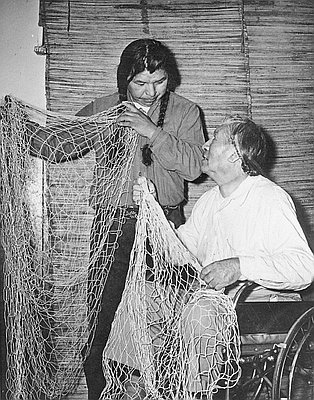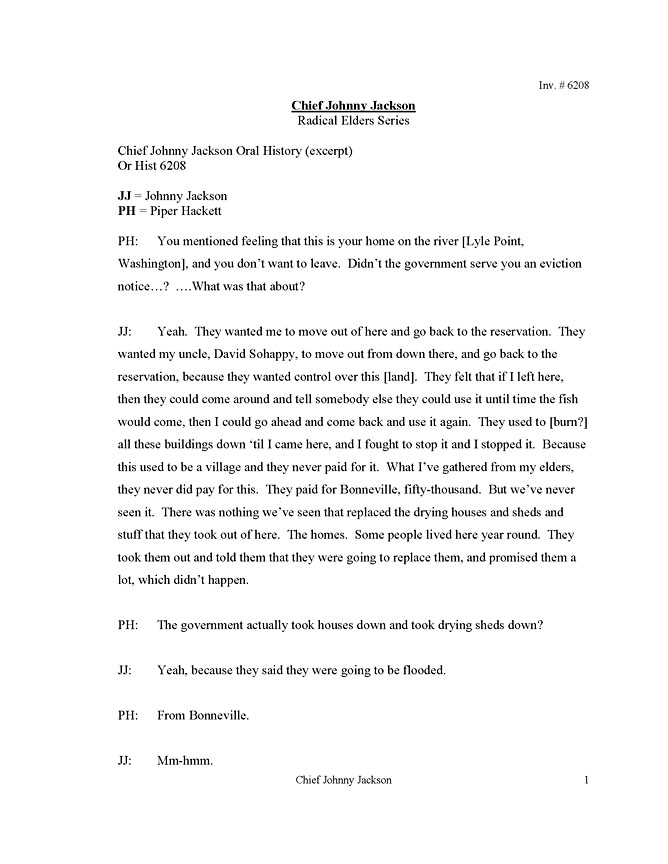- Catalog No. —
- OrHist 6208
- Date —
- March-May 1999
- Era —
- 1921-1949 (Great Depression and World War II), 1950-1980 (New Economy, Civil Rights, and Environmentalism), 1981-Present (Recent Oregon History)
- Themes —
- Environment and Natural Resources, Native Americans
- Credits —
- Oregon Historical Society
- Regions —
- Central Columbia River
- Author —
- Piper Hackett, Oral Historian
Chief Johnny Jackson's Oral History
Chief Johnny Jackson, a Columbia River Indian chief, was interviewed by Piper Hackett through the University Studies program at Portland State University. In this transcribed and edited version of Chief Jackson’s interview, he describes his people’s (Cascade and Klickitat) struggle to maintain their connections with the Columbia River and to preserve their sacred places. An unabridged version of this transcript can be viewed at the Oregon Historical Society’s research library.
Chief Jackson has been a witness, victim, and dissenter to the changes wrought by non-Indians to the mid-Columbia River and its surroundings. Beginning in 1933, the fast-moving, salmon-rich river that once coursed through the steep columnar basalt walls of the Columbia River Gorge was transformed through four decades of massive public works projects, designed by the U.S. Army Corps of Engineers, to harness the river’s hydropower, transportation, flood control, and irrigation potential. The mid-Columbia is now a series of slow-moving reservoirs punctuated by Bonneville, The Dalles, John Day, and McNary dams. The vast majority of traditional Indian fishing sites have been flooded over, the water has been polluted from agricultural runoff and industrial discharge, threatened by radioactive seepage from the Hanford Nuclear Reservation, and the surrounding landscapes have been transformed through logging and grazing operations. Additionally, Jackson notes that many of the sacred burial sites of the mid-Columbia River Indian peoples have been disturbed by grave-robbers, flooded by Army Corps projects, or built upon by entrepreneurs.
Since becoming Chief of the Cascades, Johnny Jackson has been an outspoken advocate for the preservation of Indian rights and the protection of those places which his people consider to be sacred. His struggles have ranged from a long fight to maintain a permanent home on the Columbia River in Underwood, Washington to efforts to protect and restore salmon populations and even to a recent fight to stop Enron from developing a 15,000 acre wind-power generating “farm” in the eastern portion of the Columbia River Gorge—on what his people consider to be sacred ground and environmentally sensitive habitat.
Further Reading:
Ulrich, Roberta. Empty Nets: Indians, Dams, and the Columbia River. Corvallis, Oreg., 1999.
Hunn, Eugene S. with James Selam and family. Nich’i Wána, “The Big River:” Mid-Columbia Indians and their Land. Seattle, Wash., 1991.
Written by Joshua Binus, © Oregon Historical Society, 2003.
Related Historical Records
-
Women Dry Salmon at Celilo Village
This photograph shows Warm Springs tribal members Edna David (left) and Stella McKinley (right) drying salmon at Celilo Village. It was taken by an Oregon State Highway Travel …

-
Fishing Nets
This photo shows Celilo Village residents Jimmy George, left, and Charley Quittoken, right, holding up fishing nets once used to catch salmon at Celilo Falls. Netmaking has long …

-
Dams and the Onset of the Modern Age
If there is a significant moment that marks the onset of the modern age, it may be August 6, 1945, the day an American B-29, the Enola Gay, …
